
| Dane szczegółowe: | |
| Wydawca: | Naukowe UAM |
| Rok wyd.: | 2008 |
| Oprawa: | miękka |
| Ilość stron: | 198 s. |
| Wymiar: | 170x240 mm |
| EAN: | 9788323218593 |
| ISBN: | 978-83-232185-9-3 |
| Data: | 2009-10-13 |
Opis książki:
This dissertation presents the NLP (Natural Language Processing) modules used in speech synthesis through the analysis of Hungarian. After an outline of the Hungarian language, it gives a dependency description of its syntax, based on its agglutinative morphology. The author analy/cs the communicative structure of Hungarian sentences in terms of topic-focus as in different sentence settings. The main goal of the dissertation is to establish some correlation between syntax and prosody, and to work out the syntax-prosody interface. Taking into consideration the prosody of standard colloquial Hungarian, as analyzed by computer, a three-level intonation model has been developed, and used to describe and predict the prosody of different sentence types (planned for the Hungarian speech synthesis system Profivox). Applications of synlhesi/ed speech in computerized language learning and in the augmentative Bliss system are also presented, where a restricted language generation model was proposed for the Hungarian speaking version of Bliss.
Przetwarzanie języka naturalnego dla syntezy mowy węgierskiej.
.Ta książka wprowadza czytelnika w problematykę przetwarzania języka naturalnego (NLP: Natural Language Processing) niezbędnego do syntezy mowy poprzez analizy języka węgierskiego. Jest pierwszą próbą wykorzystania analizy składniowej do syntezy mowy węgierskiej opartej na specjalnie opracowanym modelu intonacji. Autorka zaprezentuje zastosowania syntetycznej mowy w nauczaniu języków i w pomocy niepełnosprawnym - jako pomoc dydaktyczna. Książka przeznaczona dla studentów, badaczy i wszystkich zainteresowanych językiem węgierskim oraz syntezą mowy w dydaktyce i terapii niepełnosprawności.
Książka "Natural Language Processing for Hungarian Speech Synthesis" - Ilona Koutny - oprawa miękka - Wydawnictwo Naukowe UAM. Książka posiada 198 stron i została wydana w 2008 r.
Spis treści:
Acknowledgments
Symbols and abbreviations
1. Speech processing and natural language processing
1.1. Man-machine communication
1.2. NLPin speech synthesis
1.2.1. Human speech production and computer-generated speech
1.2.2. Steps oflinguistic processing
1.2.2.1. Preprocessing
1.2.2.2. Morphological analysis
1.2.2.3. Syntactic analysis
1.2.2.4. Grapheme-phoneme conversion
1.2.2.5. Superposing prosody
1.3. NLP in some TTS systems
1.3.l. MITaIk
1.3.2. Bell Labs syslern
1.3.3. Festival
1.3.4. The Hungarian system Profivox
1.4. Speech recognition
1.4.1. Recognition of isolated words
1.4.2. Recognition of continuous speech
2. Main characteristics of the Hungarian language
2.1. Phonetic-phonological system
2.1.1. Vowel inventory
2.1.2. Consonant inventory
2.1.3. Phonotactics and vowel harmony
2.1.4. Prosody and stress
2.1.5. Intonation
2.2. Agglutinative morphology
2.2.1. Declension
2.2.2. Conjugation
2.2.3. Word formation
2.3. Syntax
2.3.1. Sentence structure
2.3.2. Topic-Focus structure
2.3.3. Phrase structure
3. Dependency grammar of Hungarian
3.1. Dependency grammar
3.2. Morphosyntaclic description of word classes
3.3. Dependency patterns
3.4. Topic-Focus structure
4. Valency dictionary
5. Preprocessing and morphological analysis
5.1. Structure of the linguistic analysis
5.2. Resolution of special characters and abbreviations
5.3. Processing of numbers
5.4. Detection of sentential words
5.5. Morphological analysis with Humor
5.6. Postprocessing after the morphological analysis
6. Determination of Hungarian sentence structure
6.1. Syntagmatic (phrase) structure of Hungarian
6.1.1. Restricted verb phrases
6.1.2. Noun phrases
6.1.2.1. Simple noun phrases
6.1.2.2. Complex noun phrases
6.1.3. Adjective, adverbial and numeral phrases
6.2. Focus determination
6.2.1. Specific verbal structures and focaiizers
6.2.2. Specific structures and focali/ers in noun phrases
6.2.3. Place of the focus in the focali/cd phrase
6.2.4. Several foci and poslverbal focus in sentences
6.3. Determination of verb modifiers and idiomatic expressions
6.4. Topic determination
6.5. Sentence modality
6.5.1. Declarative sentences (D)
6.5.2. Interrogative sentences (Q)
6.5.3. Irnperalive-like sentences
6.6. Sentence structure and simple sentences
6.7. Compound and complex sentences
6.7.1. Compound sentences
6.7.2. Subordinated complex sentences
6.7.2.1. Sentences with alhat-clausc
6.7.2.2. Indirect questions
6.7.2.3. Sentences with a relative clause
6.7.2.4. Sentences with comparison
6.7.2.5. Conditional sentences
6.8. Parsing sentences
7. Syntax and prosody
7.1. Relation between syntax and prosody
7.2. Prosody models in speech synthesis
7.3. Prosody model for Hungarian
7.3.1. Method
7.3.2. Temporal structure
7.3.3. Stress
7.3.4. Intonation
8. Prosody prediction
8.1. Structure of prosody predictor
8.2. Phrase boundaries and pauses
8.3. Stress distribution
8.4. Melody assignment
8.4.1.Declarative sentences
8.4.1.1. Non-emphatic declarative sentences with topic
8.4.1.2. Declarative sentences with focus
8.4.1.3. Alternative declarative sentences
8.4.1.4. Compound and complex sentences
8.4.1.5. Complex sentences
8.4.2.Interrogalive sentences
8.4.2.1. Wh-questions
8.4.2.2. Yes/no questions
8.4.2.3. Morphologically marked yes/no questions
8.4.2.4. Alternative questions
8.4.2.5. Special questions
8.4.3. Imperative sentences
8.4.4. Optative sentences
8.4.5. Exclamative sentences
8.5. Evaluation
9. Discourse and emotions in speech synthesis
9.1. Text structure, discourse and prosody
9.1.1. Discourse markers
9.1.2. Pronouns
9.1.3. Topic and focus in dialogs
9.1.3.1. Answer to yes/no questions
9.1.3.2. Answer to alternative questions
9.1.3.3. Answer to wh-questions
9.2. Expression of emotions
10. Speech synthesis for special purpose
10.1. Application fields of synthesized speech
10.2. Application of synthesi/.ed speech in CALL
10.2.1. Language learning and computers
10.2.2. Speech synthesis and recognition in CALL
10.2.3. The teaching authoring system PAROLERN
10.3. Language model for speech communication of the disabled
10.3.1. Speaking BLISS-system for Hungarian
10.3.2. Structure of the dictionary
10.3.3. Syntagmatic generation
10.3.4. Sentence generation
10.3.5. Morphological generation
10.3.6. Evaluation
Conclusions
Bibliography
Appendix: Collection of typical sentences
Przetwarzanie języka naturalnego dla syntezy mowy węgierskiej (S t r e s z c z c n i e)
Termeszetes nyelvi feldolgozasa raagyar bes/edszinte/isben
Naturlingva prilaboro en la hungara parolsintezo (R e s u m o)

